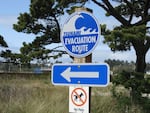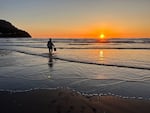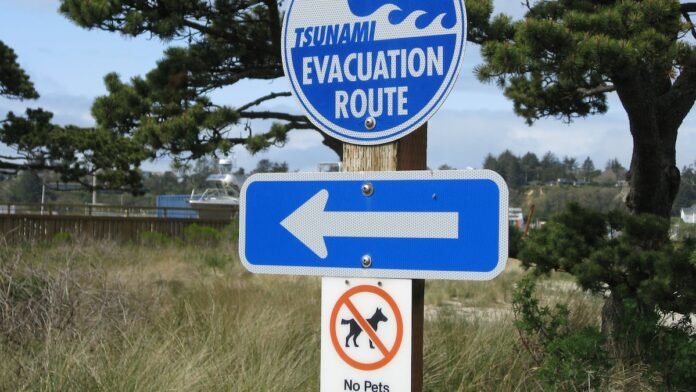EMBED YOUTUBE SHORT HERE
Just off the coast of the Pacific Northwest is the Cascadia Subduction Zone, a complex collection of earthquake faults created by one tectonic plate pushing its way under another. Every 400-600 years, it triggers a massive earthquake.
When the next one hits, damage to the region will be extensive. But now new evidence suggests current estimates about tsunami size and how quickly waves make it to shore may be too high and too fast for some parts of the Northwest coast.
With a Cascadia earthquake, coastal communities will not only contend with severe shaking, they’ll also be looking down the barrel of one or more large tsunamis. Some estimates put wave sizes at up to 100 feet.

This photo released by NOAA shows a tsunami evacuation route sign near Newport, OR.
Courtesy of the Crew and Officers of NOAA Ship MILLER FREEMAN
Triggering a tsunami that large requires the ocean floor at the fault zone to quickly heave upwards during an earthquake, pushing the water above it up into a wave. But earthquake faults come in many flavors — different orientations, depths, and sizes — and some are known to produce larger tsunamis than others.
One of these big tsunami faults is called a megasplay fault. These faults are relatively common at subduction zones around the globe. They’re generally located closer to shore than other subduction zone faults, meaning their large tsunamis hit land faster.
Seismologists had hypothesized that Cascadia would have a megasplay fault as well, running continuously from Vancouver Island to Northern California. Yet when scientists at the University of Washington actually went searching for it, they didn’t find what they were looking for.

File photo of the beach near Seaside, Oregon. New Cascadia Subduction Zone research suggests the tsunami risk for some coastal communities in the Pacific Northwest may not be quite as acute as originally thought.
Ian McCluskey / OPB
The researchers used a kind of geologic ultrasound to search for a megasplay fault along the 600-mile long Cascadia Subduction Zone. They got some positive hits, like one megasplay section off the tip of the Olympic Peninsula and another along the southern Washington and northern Oregon coasts.
But there was no evidence that the megasplay fault runs the entire length of the subduction zone. In some places, there was no evidence of a fault at all. In other areas the evidence was inconclusive.
The researchers say the earlier assumption that there is one long megasplay fault is currently built into emergency plans used by coastal communities in the Pacific Northwest. These new findings provide more detailed information and suggest Cascadia tsunamis may not be quite as large nor as fast-arriving for coastal areas that don’t have a megasplay fault offshore.
The research is published in the journal Seismica.
In these All Science Snapshots, “All Science. No Fiction.” creator Jes Burns features the most interesting, wondrous and hopeful science coming out of the Pacific Northwest.
Find full episodes of “All Science. No Fiction.” here.
And remember: Science builds on the science that came before. No one study tells the whole story.






